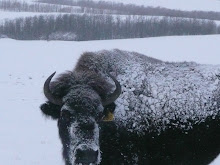Here is an excerpt from the Buffalo is Heart Healthy cookbook, available exclusively through the National Bison Association.
"Although buffalo meat is similar to beef, it needs to be handled and cooked differently. You will find most recipes for other red meats can be adapted to buffalo. The important things to remember are, DO NOT OVERCOOK!!!, and, do not let the meat dry out.
Remember "low and slow." Cook buffalo meat to the same doneness that you prefer in beef. We recommend medium/rare. Overcooked or dried out buffalo meat will bring you the same results as other meats that are overcooked - something nearly as palatable as an old boot. If you must have your meat well done, consider one of the very low temperature (180-200 degrees) recipes, where the meat is cooked for 10 hours or more. Very slow, moist heat works especially well with the less tender cuts of buffalo, such as chuck. There is nothing to compare with a buffalo chuck roast cooked all day in a slow cooker. With slow cooking, you do not have to worry about overcooking, let it cook until it falls apart.
For steak or burgers, medium heat is recommended and it is even more important to not drive off the internal moisture. Particularly for ground meat of any kind, the FDA has recommended for restaurants that meats be cooked to an internal temperature of 155 degrees. The U.S. Department of Agriculture recommends 160 degrees for home use, and because of the difficulty in determining the internal temperature of a burger patty without special equipment, recommends that burger patties be cooked to the point where the pink is just disappearing. These recommendations are primarily for ground meat since any external bacteria on steaks and roasts are killed in normal cooking.
Ground buffalo meat may be used as a substitute for ground beef in most recipes. Since ground buffalo contains very little fat, once again moderate temperatures will help insure that the meat does not scorch. With ground buffalo meat, what you see raw is what you get when it is cooked, as there is very little shrinkage in cooking."






No comments:
Post a Comment